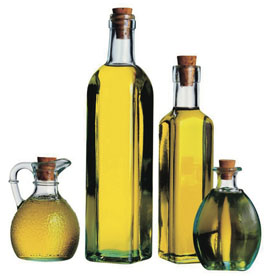Olive Oil Aeration

At first, the thought of adding olive oil to beer sounded ridiculous. Wouldn’t that make the beer taste horrible? And what about head retention? After some searching, I found out that Grady Hull, a commercial brewer with New Belgium Brewing Co. was scheduled to speak about using olive oil in place of wort aeration to a group of commercial craft brewers. I contacted Mr. Hull to find out more about the process and principles behind using olive oil as a replacement for aeration.
To begin with, one might wonder why anyone would want to replace wort aeration — don’t yeast need oxygen? In brewing, cold wort is aerated prior to fermentation to supply the yeast with oxygen. The yeast take up this oxygen and use it to produce sterols and unsaturated fatty acids (UFAs) that are required for healthy cell walls.
Although aerating cold wort leads to healthy yeast, it also causes the oxidation of some wort compounds and primes the beer to become stale later down the road. Commercial brewers work hard to exclude oxygen from every step of the brewing process. If a substitute for wort aeration was found, wort oxidation could be reduced and the flavor stability of beer could be increased.
One obvious solution would be to supply the yeast with the oxygen they need before they are pitched, thus eliminating the need to aerate the wort. However, when yeast are harvested from a previous fermentation, they have a store of glycogen and trehalose to power their metabolic processes when revived. If oxygen is added to the stored yeast, the yeast begin depleting their stores of glycogen and trehalose.
Enter Olive Oil
One of the specific UFAs that yeast cells make is oleic acid. This is an 18-carbon chain with carboxylic acid group (-COOH) on one end. Oleic acid is monounsaturated, meaning that it has one double bond in its carbon chain that is otherwise saturated (made up of single bonds). The double bond in oleic acid comes between the ninth and tenth carbon atoms, counting from the carboxylic acid end. (Take away the double bond and you would have stearic acid.) Oleic acid is found in many plant oils, especially olive oil (which can contain up to 80% oleic acid).
The idea behind olive oil aeration was to directly give the yeast the UFAs that they would normally synthesize from oxygen. This would eliminate the need to aerate the cold wort (which primes the beer to stale more quickly) or the yeast in storage (which causes them to burn up their glycogen and trehalose reserves). Essentially, the idea was to “skip the middle man.”
Previously, brewing scientists had tried the same thing with linoleic acid. If you added an extra double bond to oleic acid, between the 12th and 13th carbon molecules, you would have linoleic acid (not to be confused with linolenic acid, a relatively abundant compound found in barley malt). Linoleic acid, however, is not naturally occurring in yeast cell walls and is more expensive than oleic acid. [On the other hand, (pure) oleic acid has a melting point of 61 °F (16 °C) and would be solid at lager-brewing temperatures.]
The Experiments
Mr. Hull conducted his experiments as part of his work towards his MS in Brewing and Distilling from Heriot-Watt University located in Edinburgh, Scotland. Mr. Hull conducted experiments by adding measured amounts of olive oil to stored yeast 5 hours prior to pitching. (He did not add the olive oil directly to the wort at pitching time.) Four commercial-sized batches of New Belgium’s Fat Tire were brewed with olive oil and without aeration. In each subsequent batch, the amount of olive oil was increased. In the fourth and final batch, he added 1 milligram (mg) of olive oil per 25 billion cells.
The first batch was 360 hectoliters (hL) (9,500 gallons); the second, 720 hL (19,000 gallons) and the last two were 2,100 hL (over 55,000 gallons). The first two batches were blended into “regular” Fat Tire prior to bottling, but the final batches were sold unblended. You may have drank some of the experimental beers and did not even realize it.
Control batches of the same size were brewed concurrently using New Belgium’s normal wort aeration procedures.
In the experiment, Hull compared the fermentation time, yeast density, viability, ester production, head retention and more between the experimental olive oil beers and the controls (regular Fat Tire). In addition, all the beers were evaluated by the brewery’s normal tasting panel.
The Results
Overall, the experimental beers and the controls were very similar — similar enough that the brewery released the final experimental batches to the public. Head retention times in the experimental beers were only slightly less than that seen in controls. Fermentation times were slightly longer, but the differences between the experimental and control groups shrunk as the amount of olive oil increased. And, the beers made with olive oil attenuated as well as the control beers. Ester production was greater in the experimental beers (and remember that ester production increases as wort aeration decreases), but not to the degree that the tasting panel thought it was outside of the brand’s specifications. In fact, the tasting panel preferred the olive oil beers to the controls. And finally, when the tasting panel compared beer samples that had been aged warm for three weeks, they detected less oxidation in the olive oil beers than the aerated beers. In short, Hull’s four experiments supported the idea that olive oil could be used as a replacement for aeration, increasing the flavor stability of a beer — at least in the case of average-strength ales.
These experiments continue the work done with linoleic acid and no doubt their success will inspire more experiments. In his paper, Mr. Hull suggests several further experiments that could be conducted. Adding olive oil supplies the yeast with a UFA (oleic acid), but does not supply any sterols. As such, Hull suggests adding ergosterol to the stored yeast — both alone and in conjunction with olive oil. He further suggests that manipulations of the pitching rate, contact time between the oil and yeast and overall amount of oil added may close the gap in fermentation times.
Relevance to Homebrew
When thinking about using olive oil at a homebrew scale, it pays to review a few differences between commercial beer brewed on the scale of Fat Tire and homebrew. The reason the experiment was conducted was to find a way to extend the flavor stability of a commercial beer. Modern commercial brewhouses allow their brewers more control over the wort and beers’ exposure to oxygen compared to most homebreweries. However, we homebrewers have much better control over how our beer is handled and stored. Most of us do not have to have our beer trucked anywhere and we wouldn’t store our beer warm — or perhaps bathed in UV light, as it is in some retail locations. Also, whereas commercial brewers have little control over how old their beer is when a consumer buys (or drinks) it, homebrewers know when their beer is fresh and can drink it before signs of oxidation occur.
If you are brewing beers that ferment and condition quickly — and you store them cold and drink them before the level of oxidation bothers you — using olive oil as a replacement for aeration might be something to try if you are interested, but it certainly isn’t something that you need to do.
The difference between the yeast used in the experiment and that available to most homebrewers is worth considering, too. In the experiment, Hull added olive oil to yeast harvested from a beer fermentation. Most often, homebrewers use commercially raised yeast, perhaps added to a yeast starter a few days before brewing. Commercial yeast is grown under different conditions than a brewery fermentation. Commercial yeast suppliers raise their yeast such that fresh packages contain yeast that is healthier than “used” yeast. And, in a commercial brewery, the stored yeast harvested from a fermenter has no access to a carbon source or nutrients, as is the case in homebrew yeast starters. (This is why it’s good to aerate a yeast starter, but bad to aerate stored yeast. Imagine letting a yeast cake sit around for a couple days, then aerating it without adding any fresh wort.) If you usually make yeast starters, you could try making your starters slightly larger (~25%), aerating them thoroughly (perhaps more than once), then pitching the yeast into your un-aerated primary fermenter. (Pitch the slurry only, leaving the wort behind.)
Still, there are reasons a homebrewer may want to try olive oil. Some homebrewers do collect yeast from their fermentations and repitch. Some homebrewers — especially those who enter contests — may wish to extend the amount of time their beers are free from detectable oxidation. Some homebrewers may simply find it easier to add a tiny bit of olive oil to their yeast starter than to aerate their wort. And, of course, it’s tempting to speculate about uses that have not yet been tested — if you’re making a monster big beer, might a drop of olive oil help the yeast complete their task better? We’re all taught that high-gravity fermentations are stressful to yeast.
I discussed Grady Hull’s olive oil experiments on my podcast (BrewCrAzY) in November 2007 and since then quite a few homebrewers have tried adding olive oil to their starters.
How To Do It At Home
Depending on whether you are harvesting your yeast from a previous brew or making a yeast starter, there are a few ways you could adapt the technique for use at home. In any case, you will need to know how much olive oil to use. In Hull’s experiments, he used a maximum of 1 mg per 25 billion cells. By calculating how many yeast cells you will pitch (perhaps by using Jamil Zainascheff’s pitching rate calculator at mrmalty.com), you can figure out how much olive oil you need by taking the number of cells (in billions) and dividing by 25. For example, 5 gallons (19 L) of average-strength ale requires about 150 billion cells. This would require (150/25 =) 6 mg of olive oil.
But how do you measure 6 mg, given that most home scales only weigh to the nearest gram (g)? If oil were soluble in water, you could add 6 g to 1 L of water and then add 1mL to your yeast. But, oil is not miscible with water, so you have to take a different tack. Unless you have access to micropipettors or a serious lab scale, you are just going to have to wing it a bit. The way I add olive oil is by stripping the wire out of a twist tie, sterilizing it and inserting about 1⁄4” of the wire into the olive oil. I then stir the chilled starter wort with the wire. If you are using yeast from a prior 5-gallon (19-L) fermentation, you could probably stir a tiny drop of olive oil into the yeast cake, then take only the amount of yeast you need to pitch.
When choosing an olive oil, look at the nutritional label and compare the amounts of monounsaturated fatty acids. (Also, keep in mind that both safflower oil and sunflower oil come in high oleic acid and high linoleic acid versions).
Now I wonder what the next exciting brewing idea bouncing around the globe will be?



